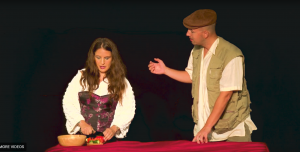
“The Lady and the Peddler” has several layers that can call for different interpretations: an allegory to Jews, gentiles and their relationships in the diaspora, a super-natural ghost story (after the German Romantic tradition) and a perverted love story, among other possibilities of interpretation.
The tale introduces Yoseph (a generic Jewish name that represents allegorically the Jewish people), a peddler who wanders between villages, trying to sell his goods and in constant search for opportunities that may come along his way, and Helleni, a gentile wealthy widow (that carries the generic allegoric female name that symbolizes the gentiles, the Hellenism and its cultural assimilation. Her name stands in contradiction to the separatism that characterized the Jews in the diaspora). They meet when Yoseph tries to seduce her into purchasing his goods. Eventually Helleni Chooses a hunting knife (that foreshadows the bloodshed to come) and dismisses Yoseph on his way. A Storm makes Yoseph ask Helleni to stay over till it passes. She allows him to use the barn and uses him to fix her roof. As she finds him useful she allows him to stay in her house, where they soon become a couple. Yoseph notices that Helleni doesn’t eat in his presence and when he questions her she tries to avoid giving straight answers, which makes him more suspicious and fearful.
The overall scheme of the story is organized across a symmetry line, which is the summit of Yoseph and Helleni’s double meaning flesh lust (for not only does Helleni have an enormous appetite for men, but she also has craving for the taste of their flesh). Till this point, the romantic relationship between Hellenyand Yoseph culminates. Yoseph moves from the barn to a storage room (Agnon uses the archaic Hebrew word “Tashmish” which also refers to sexual intercourse in order to describe this room) and from there moves into the lady’s bedroom and bed. After this peak, the relationship declines, and Yoseph is moving back into the storage room, and later on tries to escape during a storm (which correlates to the storm at the beginning of the story, that brought him to her house in the first place), just in order to be drawn back to Helleni’s house in order to find that he was rescued from her attempt to murder him, and that the starving and mad Helleni hurt herself during her attempt to kill him, and is now dying. After her death he tries to bury her in the frozen land, but when he fails to do so he leaves her body on the roof, to be eaten by the ravens, and resume his wandering.
I created the Libretto by omitting all descriptions from the story, leaving just the dialogue between the characters, and using the complex, unique, multilayered and rich language of Agnon, without any changes or additions.
I also leave an option that suggests that Yosheph might have killed Helleni. Both characters are portrayed by Agnon with harsh criticism. Yoseph is portrayed according to my interpretation as an opportunistic character that lucks integrity and values and possess a questionable morality, whereas the lady is represented as a strong, independent and dominant ‘fame fatal’, who takes advantage of the situation. Only once does Yoseph confront the lady, insisting proudly on his Jewish heritage (which he conveniently disregard previously when he stopped observing the Jewish diet laws and was having a relationship with a gentile woman). From this confrontation on the lady becomes weaker and weaker in both body and will, that allows the peddler to escape and to save his life.
I do believe that Helleni desired Yoseph passionately, and because of that she tried to keep him alive for as long as she could.
I used Jewish modal elements in the music of the peddler, as well as many repetitions in order to describe his tedious character. I ask for the low tessitura of the tenor voice in order to represent Yoseph’s stepping out of his comfort zone and character. He is a weak character yet, tries to be the great lover that Hellenydemands him to be.
Helleny’s strong and dominant features are represented in the low notes of her voice, used in a commending manner, and as she gets excited and aroused she tends to sing higher.
As there are lite motives in the novel, I used also some musical lite motives, such as the knife motive and the wandering motive that foreshadow musical and dramatic events in the opera.
The lite motives unify the piece into a cohesive and coherent work.
The opera, written for soprano and tenor, is comprised of seven scenes and its duration is about 30 minutes.